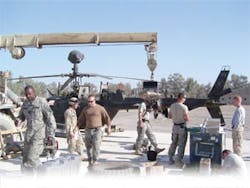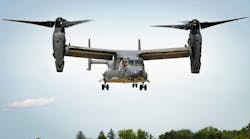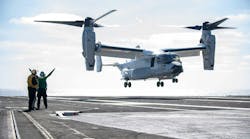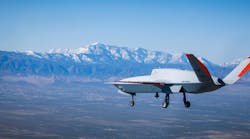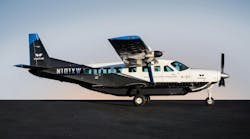“If you want to understand what it’s like being a civilian repairing U.S. Army helicopters in Iraq, just imagine that you’re a trustee in a prison,” says Ray Turner. “You’re kept confined within a fortified area, the living conditions are sparse, and the shower and toilets always leave a lot to be desired.”
As part of Rolls-Royce’s team of in-theater engineers supporting U.S. Army OH-58D Kiowa helicopters equipped with Rolls-Royce Model 250-C30R/3 engines, Turner knows what he’s talking about. In fact, Turner, fellow engineer Jerry Black, and six other Rolls-Royce technicians have been on the ground in Iraq and Afghanistan on one-year tours since 2002. Their service is part of Rolls-Royce’s Customer Logistic Support (CLS) agreement with the U.S. Army. Under the CLS contract, Rolls-Royce uses its global network of commercial parts suppliers and distributors to keep the military’s OH-58Ds in constant combat readiness.
“There are currently 220 OH-58Ds equipped with the 250-C30R/3 engine; many of which have been upgraded from earlier models,” says Larry DeMott, Rolls-Royce’s manager of Model 250 customer support. “Under our CLS contract, our job is to make sure that U.S. Army technicians have access to the parts and expertise they need in-theater, through our own engineers that are embedded with them, and parts supplied through our global network. From O-rings to engines, we handle logistics supply and delivery.” Rolls-Royce also provides similar services for other branches of the U.S. military, including the Air Force, Marines, and Navy.
Working conditions
To date, the U.S. Army’s OH-58Ds have logged more than 180,000 hours of combat flight time. On a monthly basis, that’s “four to five times what they would log in the same period stateside,” says Black. “That’s why the U.S. Army, with our help, tries to keep the Kiowas in as high a state of operational readiness as possible. Although we do work within the usual TTO and other, the first priority is to ensure that the Model 250s are always ready to go.”
To say the least, this is no easy task: Flying conditions in this part of the world are anything but ideal.
In Iraq, where both Black and Turner recently served, heat was a major problem. In some parts of the desert, the high can hit up to 130 F! “We coped by starting before dawn at 4 a.m., and then working to 11 a.m.,” Turner says. “By then, it would have become so hot that you couldn’t even touch the aircraft. So we’d break until 5 p.m. to let things cool down a bit, and then work into the night.”
Of course, this routine could only be followed if the weather cooperated. But if a sandstorm came up, all bets were off. “It would get so dusty at times, that you couldn’t even see the aircraft,” Turner tells AMT.
This same sand can wreak havoc on engine parts, which is why the U.S. Army has been installing Engine Barrier Filters in its helicopters. According to Turner and Black, the EBFs have substantially reduced engine erosion due to friction.
Still, the sand and dust gets into everything, in a working environment that often lacks air conditioning, running water, or electricity. “We are grateful for all the ‘Saddam bunkers’ that are still standing, because working inside them can provide 10 to 15 degrees difference compared to the heat outside,” says Turner. “But that’s about it: Since most lack power, it’s still working pretty rough.”
There are times when work needs to be done fast. That’s a situation Jerry Black found himself in: After being sent to Camp Anaconda near Balad, Iraq, “We were waiting for our equipment to arrive when we received word that an aircraft had made a precautionary landing (PL) at FOB Normandy and we needed to be on the flight line ready to leave for Normandy by 1300 and bring an engine with us,” he recalls.
Thanks to the can-do attitude of the U.S. Army, Black, SPC Rod Carrier, and the engine were airlifted by two UH-60 Black Hawk aircraft to FOB Normandy that afternoon. With the combined effort of a Downed Aircraft Recovery Team (DART) from FOB McKenzie, the aircraft was repaired and returned to its home base at FOB McKenzie within 48 hours. “We went back to Balad by air after that,” Black says. “It sure brought home the fact that you never know what might happen in Iraq.”
Finally, there’s the danger. Not surprisingly, Iraq is a pretty dicey place to work. To minimize the danger, the U.S. Army tends to keep its personnel within heavily guarded bases. However, even within these confines, there’s always the threat of insurgent attack.
A case in point: “Near the end of my tour, we were outside relaxing when we heard something that sounded like a jet on a flight line,” recalls Turner. “Imagine our surprise when we heard two insurgent rockets flying over the base. You’d have thought we would have all ducked for cover. But the sight was just so strange, all we could do was watch them and wonder where they were going to land.”
Another instance occurred when Black was at FOB Normandy near Muqdadiyah. (For the record, www.globalsecurity.org describes Muqdadiyah as “an insect-infested, agricultural village 80 kilometers (50 miles) northeast of Baghdad.”) “The base is in a fortified position between the village and the airfield. One night, as the sun was going down and we were working on the PLD aircraft, an IED [improvised explosive device] went off. Even where we were, you could hear the roar, see the flash, and even feel the concussion: It sure brought home the danger.”
Factor in long hours — especially those times when Turner and Black took up tools to cover for Army mechanics unexpectedly deployed to other duties — and the overall working conditions were extremely tough. In fact, one Rolls-Royce contractor in Afghanistan became so fatigued, that “he had an encounter with a OH-58’s main rotor,” says Larry DeMott. “This is a very experienced engineer, but he was just so tired that he stood up and got his head clipped by the main rotor. It took a huge chunk out of his head, but fortunately we were able to Medevac him back to the States where he recovered.
“When the doctors cleared him for duty two months later, we asked him if he wanted to return to Afghanistan, or stay home and let the guy who was covering for him stay there,” DeMott continues. “Our guy replied, ‘I want to go back.’ And so he did, despite the fact that he had been within a 1/4 inch of not surviving that rotor strike.”
The mission continues
Today, Rolls-Royce engineers continue to support Model 250-C30R/3 engines both in Afghanistan and Iraq. It’s dirty, tough, and dangerous work; a little-known battle in the War Against Terror that few know about, but that matters nonetheless.
“You try not to think about it when you’re there, even though the situation is very real,” says Ray Turner. “You’ve got a job to do, keeping those OH-58Ds airworthy and safe, and you do it.”
